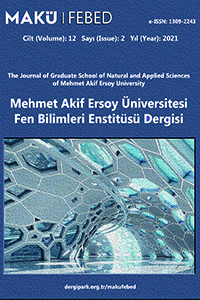Öz
Anahtar Kelimeler
Ideological context residential architecture Narkomfin Communal House Soviet residential policy
Kaynakça
- Andrusz, G. D. (1990). Housing and Urban Development in the USSR. Macmillan, 371 p.
- Arıtan, Ö. (2004). Kapitalist/ Sosyalist Modernleşme Modellerinin Erken Cumhuriyet Dönemi Mimarlığının Biçimlenişine Etkileri- Sümerbank KİT Yerleşkeleri Üzerinden Yeni Bir Anlamlandırma Denemesi. Doktora Tezi, Dokuz Eylül Üniversitesi Fen Bilimleri Enstitüsü Bina Bilgisi Ana Bilim Dalı, İzmir, 459 s.
- Buchli, V. (1998). Moisei Ginzburg’s Narkomfin Communal House in Moscow: Contesting the Social and Material World. Journal of the Society of Architectural Historians, 57: 160- 181.
- Ginzburg, A., Starostina, A. (2020a). Vladimir Ginzburg and the first steps toward the restoration of the Narkomfin Building. 1985-2015. In: The Narkomfin Building, Restoration 2016-2020, Alexey Ginzburg (auth.), Publication of Department of Cultural Heritage of the City of Moscow, 32-36. https://www.mos.ru/dkn/documents/view/248242220/ (Erişim Tarihi: 25.03.2021)
- Ginzburg, A., Starostina, A. (2020b). The Restoration Project and Its Realization. 2016-2020. In: The Narkomfin Building, Restoration 2016-2020, Alexey Ginzburg (auth.), Publication of Department of Cultural Heritage of the City of Moscow, 37-125. https://www.mos.ru/dkn/documents/view/248242220/ (Erişim Tarihi: 25.03.2021)
- Ginzburg, A., Starostina, A. (2020c). The new life of the Narkomfin building: the residential function 90 yearson. In: The Narkomfin Building, Restoration 2016-2020, Alexey Ginzburg (auth.), Publication of Department of Cultural Heritage of the City of Moscow, 37-125. https://www.mos.ru/dkn/documents/view/248242220/ (Erişim Tarihi: 25.03.2021)
- Guillén, M., F. (2008). The Taylorized Beauty of the Mechanical: Scientific Management and the Rise of Modernist Architecture. Princeton University Press, 208 p.
- Kazus, I. A. (2020). The Narkomfin building as a manifesto fort he modern way of life. In: The Narkomfin Building, Restoration 2016-2020, Alexey Ginzburg (auth.) Publication of Department of Cultural Heritage of the City of Moscow, 12-31. https://www.mos.ru/dkn/documents/view/248242220/ (Erişim Tarihi: 25.03.2021)
- Khmelnitsky, D. (2016). Moisej Ginzburg and Soviet Residential Architecture. In: Narkomfin Moisej J. Ginzburg, Ignatij F. Milinis, Danilo Udovički- Selb (ed.), Wasmuth, 192 p.
- Sherwood, R. (1981). Modern Housing Prototypes. Harvard University Press, 184 p.
- Teige, K. (2002). The Minimum Dwelling. Translated by Eric Dluhosch, MIT Press, 432 p.
- URL-1 (2015). https://monoskop.org/images/3/39/Sovremennaya_arkhitektura_1927_4-5.pdf (Erişim Tarihi: 30.12.2020)
- URL-2 (2020). http://inrussia.com/tour-the-house-of-narkomfin (Erişim Tarihi: 30.12.2020)
- URL-3 (2012). https://laboratoireurbanismeinsurrectionnel.blogspot.com/2012/04/urss-habitat-et-dom-kommuny.html (Erişim Tarihi: 16.04.2021)
- URL-4 (2017). https://www.architectural-review.com/essays/making-sense-of-narkomfin (Erişim Tarihi: 17.04.2021)
- URL-5 (2015). https://i.pinimg.com/564x/9d/92/e8/9d92e88ad6da4661e08d5c74367abcbf.jpg (Erişim Tarihi: 30.12.2020)
- URL-6 (2021). https://ginzburg-architects.com/en/projects/restoration/zdanie-prachechnoj-narkomifina (Erişim Tarihi: 17.04.2021)
- URL-7 (2020). https://ginzburg-architects.com/media/projects/Proj1/Prachechnaya_narkomfina_before_restoration_2048x1500.jpg (Erişim Tarihi: 05.06.2021)
- URL-8 (2020). https://ginzburg-architects.com/media/projects/Narkomfin/Ot_14_01_2020/_YPL4233.jpg (Erişim Tarihi: 17.04.2021)
- URL-9 (2021). https://ginzburg-architects.com/media/projects/prachechnaya-narkomfina.jpg (Erişim Tarihi: 17.04.2021)
- URL-10 (2020). https://www.archdaily.com/947148/the-winding-saga-of-the-restoration-of-the narkomfin-an-icon-of-soviet-constructivism (Erişim Tarihi: 24.01.2021)
- Vega, D. M. (2020). Housing and Revolution: From the Dom-Kommuna to the Transitional Type of Experimental House (1926–30). Architectural Histories, 8(1): 2; DOI: http://doi.org/10.5334/ah.264
Öz
Anahtar Kelimeler
İdeolojik bağlam konut mimarisi Narkomfin Komünal Konutu Sovyet konut politikası
Kaynakça
- Andrusz, G. D. (1990). Housing and Urban Development in the USSR. Macmillan, 371 p.
- Arıtan, Ö. (2004). Kapitalist/ Sosyalist Modernleşme Modellerinin Erken Cumhuriyet Dönemi Mimarlığının Biçimlenişine Etkileri- Sümerbank KİT Yerleşkeleri Üzerinden Yeni Bir Anlamlandırma Denemesi. Doktora Tezi, Dokuz Eylül Üniversitesi Fen Bilimleri Enstitüsü Bina Bilgisi Ana Bilim Dalı, İzmir, 459 s.
- Buchli, V. (1998). Moisei Ginzburg’s Narkomfin Communal House in Moscow: Contesting the Social and Material World. Journal of the Society of Architectural Historians, 57: 160- 181.
- Ginzburg, A., Starostina, A. (2020a). Vladimir Ginzburg and the first steps toward the restoration of the Narkomfin Building. 1985-2015. In: The Narkomfin Building, Restoration 2016-2020, Alexey Ginzburg (auth.), Publication of Department of Cultural Heritage of the City of Moscow, 32-36. https://www.mos.ru/dkn/documents/view/248242220/ (Erişim Tarihi: 25.03.2021)
- Ginzburg, A., Starostina, A. (2020b). The Restoration Project and Its Realization. 2016-2020. In: The Narkomfin Building, Restoration 2016-2020, Alexey Ginzburg (auth.), Publication of Department of Cultural Heritage of the City of Moscow, 37-125. https://www.mos.ru/dkn/documents/view/248242220/ (Erişim Tarihi: 25.03.2021)
- Ginzburg, A., Starostina, A. (2020c). The new life of the Narkomfin building: the residential function 90 yearson. In: The Narkomfin Building, Restoration 2016-2020, Alexey Ginzburg (auth.), Publication of Department of Cultural Heritage of the City of Moscow, 37-125. https://www.mos.ru/dkn/documents/view/248242220/ (Erişim Tarihi: 25.03.2021)
- Guillén, M., F. (2008). The Taylorized Beauty of the Mechanical: Scientific Management and the Rise of Modernist Architecture. Princeton University Press, 208 p.
- Kazus, I. A. (2020). The Narkomfin building as a manifesto fort he modern way of life. In: The Narkomfin Building, Restoration 2016-2020, Alexey Ginzburg (auth.) Publication of Department of Cultural Heritage of the City of Moscow, 12-31. https://www.mos.ru/dkn/documents/view/248242220/ (Erişim Tarihi: 25.03.2021)
- Khmelnitsky, D. (2016). Moisej Ginzburg and Soviet Residential Architecture. In: Narkomfin Moisej J. Ginzburg, Ignatij F. Milinis, Danilo Udovički- Selb (ed.), Wasmuth, 192 p.
- Sherwood, R. (1981). Modern Housing Prototypes. Harvard University Press, 184 p.
- Teige, K. (2002). The Minimum Dwelling. Translated by Eric Dluhosch, MIT Press, 432 p.
- URL-1 (2015). https://monoskop.org/images/3/39/Sovremennaya_arkhitektura_1927_4-5.pdf (Erişim Tarihi: 30.12.2020)
- URL-2 (2020). http://inrussia.com/tour-the-house-of-narkomfin (Erişim Tarihi: 30.12.2020)
- URL-3 (2012). https://laboratoireurbanismeinsurrectionnel.blogspot.com/2012/04/urss-habitat-et-dom-kommuny.html (Erişim Tarihi: 16.04.2021)
- URL-4 (2017). https://www.architectural-review.com/essays/making-sense-of-narkomfin (Erişim Tarihi: 17.04.2021)
- URL-5 (2015). https://i.pinimg.com/564x/9d/92/e8/9d92e88ad6da4661e08d5c74367abcbf.jpg (Erişim Tarihi: 30.12.2020)
- URL-6 (2021). https://ginzburg-architects.com/en/projects/restoration/zdanie-prachechnoj-narkomifina (Erişim Tarihi: 17.04.2021)
- URL-7 (2020). https://ginzburg-architects.com/media/projects/Proj1/Prachechnaya_narkomfina_before_restoration_2048x1500.jpg (Erişim Tarihi: 05.06.2021)
- URL-8 (2020). https://ginzburg-architects.com/media/projects/Narkomfin/Ot_14_01_2020/_YPL4233.jpg (Erişim Tarihi: 17.04.2021)
- URL-9 (2021). https://ginzburg-architects.com/media/projects/prachechnaya-narkomfina.jpg (Erişim Tarihi: 17.04.2021)
- URL-10 (2020). https://www.archdaily.com/947148/the-winding-saga-of-the-restoration-of-the narkomfin-an-icon-of-soviet-constructivism (Erişim Tarihi: 24.01.2021)
- Vega, D. M. (2020). Housing and Revolution: From the Dom-Kommuna to the Transitional Type of Experimental House (1926–30). Architectural Histories, 8(1): 2; DOI: http://doi.org/10.5334/ah.264
Ayrıntılar
| Birincil Dil | Türkçe |
|---|---|
| Konular | Mimarlık |
| Bölüm | Derleme Makale |
| Yazarlar | |
| Yayımlanma Tarihi | 1 Aralık 2021 |
| Kabul Tarihi | 10 Haziran 2021 |
| Yayımlandığı Sayı | Yıl 2021 Cilt: 12 Sayı: 2 |

